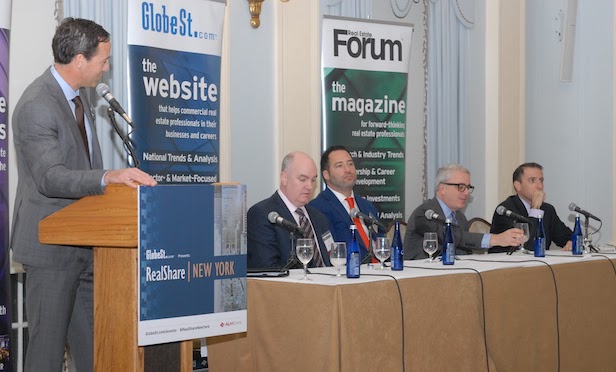 From left: Peter Von Der Ahe, Jim Costello, Jared Epstein, Saul Scherl and Seth Pinsky/ Photo by Charles Garnar
From left: Peter Von Der Ahe, Jim Costello, Jared Epstein, Saul Scherl and Seth Pinsky/ Photo by Charles Garnar
Paraphrasing former Mayor Michael Bloomberg's realization that the root of what drives businesses' location decisions is access to talent, Seth Pinksy, EVP fund manager at RXR Realty said:
“If you could invest in creating the kind of quality of life in a city that would attract the best and the brightest, the best and the brightest in turn would attract businesses and would create a virtuous cycle.”
Pinsky was the NYCEDC president and director of former Mayor Michael Bloomberg's special initiative for rebuilding and resiliency. He said that during his tenure in city government, economic development was less geared towards pursuing specific businesses and specific job creation opportunities, and instead emphasized creating an environment that would attract a 21st century workforce.
At the RealShare New York 2018 panel “Cautious Optimism: The New York Deal Sheet,” on Tuesday, Pinksy was joined by speakers Jared Epstein, VP and principal of Aurora Capital Associates; Jim Costello, SVP, Real Capital Analytics; and Saul Scherl, president of the New York tri-state region at the Howard Hughes Corporation.
Pinsky further pointed to Amazon's decision to bring one of its second headquarters to New York.
The development of the Cornell Tech Roosevelt Island campus was part of Bloomberg's initiative to create a national tech hub to diversify the economy. NYCEDC continued managing the project under Mayor Bill de Blasio, with the campus officially opening in September 2017.
“I really believe that campus was one of the main reasons that Amazon not only decided to locate in New York but specifically decided to locate in Long Island City right across the East River, right across from the campus,” said Pinsky.
In describing New York real estate, the panel moderator, Marcus & Millichap's Peter Von Der Ahe, referenced hockey star Wayne Gretzky's quote: “It's not where the puck is but where it's going to go.”
New York City is constantly moving—continually reinventing itself. Von Der Ahe asked the panelists about the city's evolving real estate.
“We started buying the property in the Meatpacking District in 2009 right at the bottom of the cycle,” said Epstein, whose company is well-known for owning buildings in that neighborhood. “The streetscape of the Meatpacking District is phenomenal. With the street grid, there are open wide vistas and plazas. There are great old store buildings everywhere and cobblestone streets.”
He applauded the Landmarks Preservation Commission for keeping the history of the neighborhood undisturbed while also allowing developers to add onto buildings, creating new structures.
“My partner and I saw this could be the coolest, hippest neighborhood in Manhattan and could attract and maintain talent,” said Epstein. “This area could become a boon for economic development for companies, corporate headquarters, and it wasn't just about retail.”
Epstein traced Apple's coming to the neighborhood and high-end fashion transforming 14th Street. He noted retail started leaving because there was no community to sustain the rents the retailers were paying. But with Google acquiring 111 Eighth Ave. and Chelsea Market, other tech companies wanted to be nearby. The High Line and the Whitney Museum also continued to boost revitalization.
It now seems difficult to imagine the neighborhood's once gritty reputation as an area known for prostitution. Starbucks is preparing to launch its largest 20,000 square-foot Reserve Roastery on Ninth Avenue and in the spring Hermes is opening a store geared toward younger shoppers, around the corner on Gansevoort St.
The Seaport District has also evolved after Hurricane Sandy. The Howard Hughes Corporation studied historic pictures of the area to understand its roots to build upon them. The company recognized it had to “bring the neighborhood up to speed and focus on experiential retail to bring it to where we want it to be,” Scherl said. He listed ESPN, Nike and SJP Collection, Sarah Jessica Parker's shoe store, as quality tenants that moved to the district, boosting its appeal.
The panelists agreed that now in New York's highly desirable neighborhoods, there is a large bid-ask spread. “And it's not going away,” said Epstein. “You would think prices are getting more realistic but they are simply not. It's brutal out there.”
But Costello summed up the competitive appeal of New York.
“There's definitely more debt and there's definitely plenty of equity. When you're in the city and you're feeling like things are bad and you need something better, someplace else. Not really. This is one of the most productive economies in the world and there's a lot of money that wants to come here.”
© Touchpoint Markets, All Rights Reserved. Request academic re-use from www.copyright.com. All other uses, submit a request to [email protected]. For more inforrmation visit Asset & Logo Licensing.







